Papers by José Marcelo S Viana
Resumen pt: O uso do Delineamento I em programa de melhoramento populacional de milho permite emp... more Resumen pt: O uso do Delineamento I em programa de melhoramento populacional de milho permite empregar uma das seguintes estrategias de selecao: entre progenies de i...
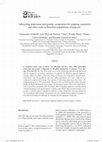
Ciencia e investigación agraria, 2010
Inbreeding depression and genetic components in Brazilian populations of popcorn. Cien. Inv. Agr.... more Inbreeding depression and genetic components in Brazilian populations of popcorn. Cien. Inv. Agr. 37(3):125-132. The aim of the study was to assess inbreeding depression and determine genetic components in landrace populations of popcorn. Six Brazilian popcorn landraces: Amarelo, Beija-Flor, Branco, Rosa-claro, Roxo and Viçosa, were subjected to self-pollination. Experiments with S0 populations and their selfing populations (S1) were conducted in a randomized complete block design. The estimates of inbreeding depression varied from 1.2% (popping expansion) to 79% (grain yield). The gene action was predominantly additive for plant height, ear height and hundred-grain-weight. The dominance genetic effects were important for index of prolificacy and grain yield. The genetic effect of popping expansion was bidirectional with null dominance and a predominance of additive gene effects. Based on these results, it was possible to identify popcorn populations suitable to extract inbred lines, develop hybrids and use in population improvement. The present study also confirmed that popping expansion is a trait that can be improved efficiently by recurrent selection programs of popcorn.
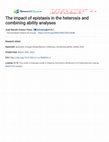
The current theoretical knowledge concerning the influence of epistasis on heterosis is based on ... more The current theoretical knowledge concerning the influence of epistasis on heterosis is based on simplified multiplicative model. The objective of this study was to assess the impact of epistasis in the heterosis and combining ability analyses, assuming additive model, hundreds of genes, linkage disequilibrium (LD), dominance, and seven types of digenic epistasis. We developed the quantitative genetics theory for supporting the simulation of the individual genotypic values in nine populations, the selfed populations, the 36 interpopulation crosses, 180 doubled haploids (DHs) and their 16,110 crosses, assuming 400 genes in 10 chromosomes of 200 cM. Epistasis only affects population heterosis if there is LD. Only additive x additive and dominance x dominance epistasis can affect the components of the heterosis and combining ability analyses of populations. Both analyses can lead to completely wrong inferences regarding the identification of the superior populations, the populations wi...
DOAJ (DOAJ: Directory of Open Access Journals), May 1, 2008
Resumo Dois experimentos foram montados em Viçosa-MG, objetivando estimar as herdabilidades no se... more Resumo Dois experimentos foram montados em Viçosa-MG, objetivando estimar as herdabilidades no sentido amplo e as correlações de alguns caracteres de interesse agronômico em plantas F 2 de soja, oriundas do cruzamento entre uma linhagem TN ( ...
Crop Breeding and Applied Biotechnology, Jun 30, 2002
Two selection methods based on distance from ideotype using selection index and principal compone... more Two selection methods based on distance from ideotype using selection index and principal components are proposed. They took into consideration the existence of an optimum range for each trait, the difference in scale of the measurements and the relative importance of the traits. The index was also based on mean Euclidean distance. Analysis performed by considering four eggplant traits and a 35,3% selection pressure showed that the two selection methods presented the same predicted genetic gains.
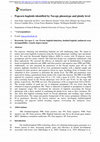
bioRxiv (Cold Spring Harbor Laboratory), Mar 20, 2023
For popcorn, obtaining and identifying haploids are still challenging steps. We aimed to induce a... more For popcorn, obtaining and identifying haploids are still challenging steps. We aimed to induce and screen haploids in popcorn using the Navajo phenotype, seedling vigor and ploidy level. We used the Krasnodar Haploid Inducer (KHI) in crosses with 20 popcorn source germplasms and five maize controls. The field trial design was completely randomized, with three replications. We assessed the efficacy of induction and of identification of haploids based on haploidy induction rate (HIR) and false positive and negative rates (FPR and FNR). Additionally, we also measured the penetrance of the Navajo marker gene (R1-nj). All putative haploids classified by R1-nj were germinated together with a diploid sample and evaluated for false positives and negatives based on vigor. Seedlings from 14 females were submitted to flow cytometry to determine the ploidy level. The HIR and penetrance were analyzed by fitting a generalized linear model with a logit link function. The HIR of the KHI, adjusted by cytometry, ranged from 0.0 to 1.2%, with a mean of 0.34%. The average FPR from screening based on the Navajo phenotype were 26.2% and 76.4%, by the vigor and ploidy, respectively. The FNR was zero. The penetrance of R1-nj ranged from 30.8 to 98.6%. The average number of seeds per ear in temperate germplasm (76) was lower than that obtained in tropical germplasm (98). There is induction of haploids in germplasm of tropical and temperate origin. We recommend the selection of haploids associating the Navajo phenotype with a direct method of confirming the ploidy level, such as flow cytometry. We also show that haploid screening based on Navajo phenotype and seedling vigor reduces misclassification. The origin and genetic background of the source germplasm influence the R1-nj penetrance. Because the known inducers are maize, developing doubled-haploid technology for popcorn hybrid breeding requires overcoming the unilateral crossincompatibility.

Ceres, Apr 1, 2015
O cupunuzeiro e uma fruteira amazonica promissora, destinada principalmente para fins industriais... more O cupunuzeiro e uma fruteira amazonica promissora, destinada principalmente para fins industriais. Contudo sua expansao requer pesquisas que promovam o elhoramento genetico e ambiental. Visando ao desenvolvimento de material melhorado, foram avaliadas 20 progenies de meios-irmaos, na Fazenda Experimental da Faculdade de Ciencias Agrarias da Universidade Federal do Amazonas, em Manaus. 0 delineamento experimental utilizado foi o de blocos ao acaso, corn 20 tratamentos e trey repetigoes. As 20 progenies foram medidas em tres periodos (tres safras) sucessivos, no ano agricola 199b/97. Vdrios parametros geneticos foram estimados. 0 metodo dos componentes principais foi usado para estimar o coeficiente de repetibilidade. Em todos os caracteres avaliados, detectowse a presenca de variabilidade genetica significativa. 4s valores estimados para a herdabilidade indicam que a sele0o sera eficiente para varias caracteristicas. Sao necessarias pelo menos duas mediVies nas caracteristicas peso medio dos frutos e producaode frutos por pIanta, pars se ter 95% de confiabilidade do valor fenotipico medio Como indicador do valor genotipico. Pelo menos dual mediOes nas caracteristicas peso m6dio da polpa e peso medio das sementes sao necessdrias pars se ter 90% de confiabilidade de o valor fenotipico revelar a superioridade das unidades de sele0o.
Genetics and Molecular Research, 2017
Genomic selection (GS) is a variant of marker-assisted selection, in which genetic markers coveri... more Genomic selection (GS) is a variant of marker-assisted selection, in which genetic markers covering the whole genome predict individual genetic merits for breeding. GS increases the accuracy of breeding values (BV) prediction. Although a variety of statistical models have been proposed to estimate BV in GS, few methodologies have examined statistical challenges based on non-normal phenotypic distributions, e.g., skewed distributions. Traditional GS models estimate changes in the phenotype distribution mean, i.e., the function is defined for the expected value of trait-conditional on markers, E(Y|X). We proposed an approach based on regularized quantile regression (RQR) for GS to improve the estimation of marker effects BLASSO were 86.28 and 55.70% for positively and negatively skewed distributions, respectively.
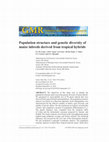
Genetics and Molecular Research, 2014
The objectives of this study were to identify the population structure and to assess the genetic ... more The objectives of this study were to identify the population structure and to assess the genetic diversity of maize inbreds. We genotyped 81 microsatellite loci of 90 maize inbreds that were derived from tropical hybrids and populations. The population structure analysis was based on a Bayesian approach. Each subpopulation was characterized for the effective number of alleles, gene diversity, and number of private alleles. We also performed an analysis of molecular variance and computed a measure of population differentiation (F ST). The genetic distances were computed from the similarity index of Lynch and the dissimilarity measures proposed by Smouse and Peakall. The cluster analyses were based on the unweighted pair-group method using arithmetic averages and Tocher method. The clustering efficiency was assessed by the error rate of the discriminant analysis. We also performed a principal coordinates analysis. The population structure analysis revealed three tropical heterotic pools, which have ©FUNPEC-RP www.funpecrp.com.br Genetics and Molecular Research 13 (3): 7365-7376 (2014) E.C.M. Lanes et al. been used by worldwide and Brazilian maize seed companies. The degree of genetic differentiation and of intra-and inter-population genetic diversity for these tropical heterotic pools are comparable to that observed for temperate and subtropical heterotic pools. The higher allelic frequency variation within each tropical heterotic pool and the high genetic diversity between the inbreds were evidence of heterotic groups within the main tropical heterotic pools.
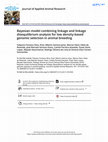
Journal of Applied Animal Research, 2017
We combined linkage (LA) and linkage disequilibrium (LDA) analyses (emerging the term 'LALDA') fo... more We combined linkage (LA) and linkage disequilibrium (LDA) analyses (emerging the term 'LALDA') for genomic selection (GS) purposes. The models were fitted to a simulated dataset and to a real data of feed conversion ratio in pigs. Firstly, the significant QTLs (quantitative trait locus) were identified through LA-based mixed models considering the QTL-genotypes as random effects by means of genotypic identity by descent matrix. This matrix was calculated at the positions of significant QTLs (based on LA) allowing to include the QTL-genotype effects additionally to SNP (single nucleotide polymorphism) markers (based on LDA) and additive polygenic effects in several GS models (Bayesian Ridge Regression-BRR; Bayes A-BA; Bayes B-BB; Bayes C-BC and Bayesian LASSO-BL). These models combing all mentioned effects were denominated LALDA. Goodness-of-fit and predictive ability analyses were performed to evaluate the efficiency of these models. For the real data, although slightly, the superiority of the LALDA models was verified in comparison to traditional LDA models for GS. For the simulated dataset, the models presented similar results. For both LDA and LALDA frameworks, BA showed the best fitting through Deviance Information Criterion and higher predictive ability in the simulated and real datasets.
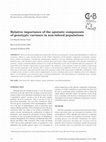
Cropp Breeding and Applied Biotechnology, 2004
There are theoretical approaches about genic interaction in polygenic systems and methodologies t... more There are theoretical approaches about genic interaction in polygenic systems and methodologies to confirm its occurrence. However, some relevant aspects as the relative importance of the epistatic components of genotypic variance deserve further investigation. Considering complementary, duplicate, recessive, dominant, dominant and recessive epistasis, duplicate genes with cumulative effects and non-epistatic genic interaction, relative magnitudes of the epistatic components of genotypic variance assuming digenic epistasis were analyzed. Regardless of the type of epistasis and gene frequencies, the magnitudes of the epistatic components are proportional to the complexity of the polygenic system, the number of interacting genes and the magnitude of the epistatic effects relative to the deviations a (difference between the genotypic value of the homozygote with greater expression and the mean of the genotypic values of the homozygotes) and d (due to dominance). Only in simple genetic systems or in those where complementary, recessive, dominant and recessive, duplicate genes with cumulative effects, or non-epistatic gene interaction types of epistasis predominate, with high frequencies of dominant genes, epistatic components can be of reduced or negligible magnitude.
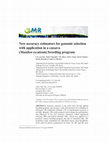
Genetics and Molecular Research, 2016
Genomic selection is the main force driving applied breeding programs and accuracy is the main me... more Genomic selection is the main force driving applied breeding programs and accuracy is the main measure for evaluating its efficiency. The traditional estimator (TE) of experimental accuracy is not fully adequate. This study proposes and evaluates the performance and efficiency of two new accuracy estimators, called regularized estimator (RE) and hybrid estimator (HE), which were applied to a practical cassava breeding program and also to simulated data. The simulation study considered two individual narrow sense heritability levels and two genetic architectures for traits. TE, RE, and HE were compared under four validation procedures: without validation (WV), independent validation, tenfold validation through jacknife allowing different markers, and with the same markers selected in each cycle. RE presented accuracies closer to the parametric ones and less biased and more precise ones than TE. HE proved to be very effective in the WV procedure. The estimators were applied to five traits evaluated in a cassava experiment, including 358 clones genotyped for 390 SNPs. Accuracies ranged from 0.67 to 1.12 with TE and from 0.22 to 0.51 with RE. These results indicated that TE overestimated the accuracy and led to one accuracy estimate (1.12) higher than one, which is outside of the parameter space. Use of RE turned the accuracy into the parameter space. Cassava breeding programs can be more realistically implemented using the new estimators proposed in this study, providing less risky practical inferences.
Acta Scientiarum Agronomy
Resumo Dois experimentos foram montados em Viçosa-MG, objetivando estimar as herdabilidades no se... more Resumo Dois experimentos foram montados em Viçosa-MG, objetivando estimar as herdabilidades no sentido amplo e as correlações de alguns caracteres de interesse agronômico em plantas F 2 de soja, oriundas do cruzamento entre uma linhagem TN ( ...
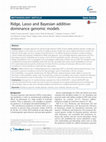
BMC genetics, Jan 25, 2015
A complete approach for genome-wide selection (GWS) involves reliable statistical genetics models... more A complete approach for genome-wide selection (GWS) involves reliable statistical genetics models and methods. Reports on this topic are common for additive genetic models but not for additive-dominance models. The objective of this paper was (i) to compare the performance of 10 additive-dominance predictive models (including current models and proposed modifications), fitted using Bayesian, Lasso and Ridge regression approaches; and (ii) to decompose genomic heritability and accuracy in terms of three quantitative genetic information sources, namely, linkage disequilibrium (LD), co-segregation (CS) and pedigree relationships or family structure (PR). The simulation study considered two broad sense heritability levels (0.30 and 0.50, associated with narrow sense heritabilities of 0.20 and 0.35, respectively) and two genetic architectures for traits (the first consisting of small gene effects and the second consisting of a mixed inheritance model with five major genes). G-REML/G-BLUP...
Journal of animal breeding and genetics = Zeitschrift für Tierzüchtung und Züchtungsbiologie, 2014
The objective of this work was to evaluate the efficiency of the supervised independent component... more The objective of this work was to evaluate the efficiency of the supervised independent component regression (SICR) method for the estimation of genomic values and the SNP marker effects for boar taint and carcass traits in pigs. The methods were evaluated via the agreement between the predicted genetic values and the corrected phenotypes observed by cross-validation. These values were also compared with other methods generally used for the same purposes, such as RR-BLUP, SPCR, SPLS, ICR, PCR and PLS. The SICR method was found to have the most accurate prediction values.

Uploads
Papers by José Marcelo S Viana